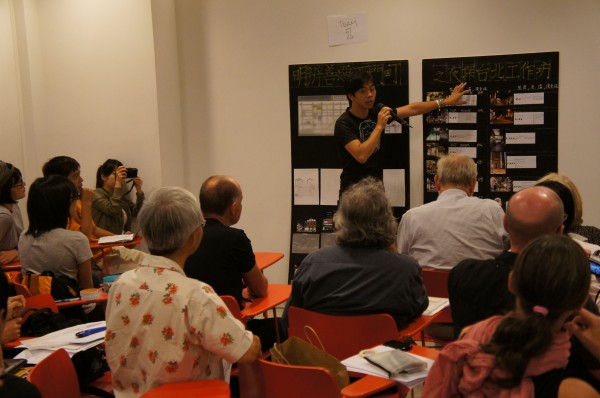Since 1999, the Transnational Tanteidan (TNT) has been traveling around the world to survey lighting conditions in different cities. This time, they traveled to Taiwan and had a short but impressive event with Taiwanese people. In this event, members of TNT discussed with participants on their survey and went out to detect lighting conditions in five areas in Taipei City. That was a typhoon night, yet these detectives didn’t be defeated by the wind and rain. They walked in the areas and observed carefully to find out heroes and villains – good lighting and bad lighting.
The full English title of TNT is “Transnational Lighting Detectives” as “tanteidan” means “detectives” in Japanese. On 1999, TNT started their first Tanteidan Night Watching Tour in Tokyo, Japan – an event that assigns specific areas to teams that constituted by five to nine participants (a.k.a. students) and searches for heroes and villains. The basic concept, as well as the central idea, is to designate good lighting in a city, and the detectives call good lighting a “hero” while bad lighting a “villain.” The event in Taipei also followed the same process. On early September, TNT’s leader Kaoru Mende, Taiwanese member Uno Lai and the Taiwan sponsor Xue Xue Institute selected five areas in Taipei City from eastern to western part for five teams to do their survey. For the next three weeks, all the students have to detect the area they got assigned and try to search for good and bad lighting through their feeling and present their results.
-

-
Students presented their panels to teachers.
Photo Credit: TNT
In order to explain their projects, students were asked to create three panels – the first one was for explaining the area’s surroundings, the second one was about their analysis (the heroes and villains they found) and the third one was their solutions to those bad lighting. On the previous presentation on 20th September, TNT members listened and gave suggestions to students’ panels, explaining the most important concept of distinguishing good and bad lighting. “What important is how you feel,” said a member of TNT. “We want to know what your criteria are.” After that, five teams went to detect their areas with their teachers respectively in the night.
That was a typhoon night, yet everyone was energetic and active. Students led their teachers (two to three teachers for each team) to visit the points they had found and expressed their opinions. After observing the situations, teachers provided their professional points of view and precise problems to solve. During their tours, teachers would share their inspections on lighting designs they encountered along streets. They felt, saw, perceived and exchanged opinions together; through such processes, students can understand what “lighting” is while teachers can grab some ideas about how laymen think. They worked together in the wind and rain, some looked up for more heroes or villains, some tried to sketched the streets and some took photos for presentation. It was evident that they came up with something innovative throughout the event.
-

-
After finishing Night Watching Tour with teachers, all team members discussed their opinions and observations.
Photo Credit: TNT
-

-
student started modifying their panels under teachers' suggestions.
Photo Credit: TNT
-

-
According to TNT members, sketching is a good method for students to express their feelings.
Photo Credit: TNT
21st September was the formal presentation day. Students had modified their panels according to teachers’ suggestions and had managed to find out more solutions to the lighting problems. With help from TNT members, all those good presentations became even better and led every audience to reconsider the lighting conditions in Taipei City. After the teams finished their presentation, all TNT members had a short talk to the audiences. They didn’t only mention about their feelings to this Taipei event but also pointed out why they have the Night Watching Tour – it’s all about interactions.
Interaction between students and teachers, professionals and laymen and light and the surroundings; they are all based on interaction between people and light. As the TNT members said, the main criteria are actually HOW YOU FEEL – is the lighting comfortable or offending to you? The central idea of TNT’s events is to feel the light surrounding you and they believe that this is the only way to recreate a better lighting circumstance. “We all know that good or bad lighting can’t be concluded by only one aspect,” said a TNT member. “So we need observation, discussion and argument on the light from various angles, and then, we can conclude what good lighting is.” They also pointed out a cultural perspective of lighting: light can benefit to the society and it is necessary to learn. “Feel the light!” emphasized by Mende, hence we can understand why the title “Lighting Detectives.”
-

-
Listening to students' formal presentations.
Photo Credit: TNT
-

-
Students gave their presentations with powerpoint files.
Photo Credit: TNT
-

-
A short but impressive discussion with all TNT members.
All the panels are now on display on the fourth floor of Xue Xue Institute building.
Related post: Lighting Master Kaoru Mende Invites You to Immerse Into the Lighting World



















